|
|
|
ADVERTISEMENTS
|
|
PREMIUM
- HAPPY HOLIDAYS!
- Siliconeer Mobile App - Download Now
- Siliconeer - Multimedia Magazine - email-Subscription
- Avex Funding: Home Loans
- Comcast Xfinity Triple Play Voice - Internet - TV
- AKSHAY PATRA - Bay Area Event - Sat. Dec 6
- Calcoast Mortgage - Home Loans
- New Homes in Silicon Valley: City Ventures - Loden Place - Morgan Hill
- Bombay to Goa Restaurant, Sunnyvale
- Buying, Sellling Real Estate in Fremont, SF Bay Area, CA - Happy Living 4U - Realtor Ashok K. Gupta & Vijay Shah
- Sunnyvale Hindu Temple: December Events
- ARYA Global Cuisine, Cupertino - New Year's Eve Party - Belly Dancing and more
- Bhindi Jewellers - ROLEX
- Dadi Pariwar USA Foundation - Chappan Bhog - Sunnyvale Temple - Nov 16, 2014 - 1 PM
- India Chaat Cuisine, Sunnyvale
- Matrix Insurance Agency: Obamacare - New Healthcare Insurance Policies, Visitors Insurance and more
- New India Bazar: Groceries: Special Sale
- The Chugh Firm - Attorneys and CPAs
- California Temple Schedules
- Christ Church of India - Mela - Bharath to the Bay
- Taste of India - Fremont
- MILAN Indian Cuisine & Milan Sweet Center, Milpitas
- Shiva's Restaurant, Mountain View
- Indian Holiday Options: Vacation in India
- Sakoon Restaurant, Mountain View
- Bombay Garden Restaurants, SF Bay Area
- Law Offices of Mahesh Bajoria - Labor Law
- Sri Venkatesh Bhavan - Pleasanton - South Indian Food
- Alam Accountancy Corporation - Business & Tax Services
- Chaat Paradise, Mountain View & Fremont
- Chaat House, Fremont & Sunnyvale
- Balaji Temple - December Events
- God's Love
- Kids Castle, Newark Fremont: NEW COUPONS
- Pani Puri Company, Santa Clara
- Pandit Parashar (Astrologer)
- Acharya Krishna Kumar Pandey
- Astrologer Mahendra Swamy
- Raj Palace, San Jose: Six Dollars - 10 Samosas
CLASSIFIEDS
MULTIMEDIA VIDEO
|
|
|
|
|
TRAVEL:
Gardens in Bloom: Ballarat, Australia
The botanical gardens are a lovely place to visit in the town of Ballarat in Australia’s Victoria state, once a boomtown following a gold rush. A Siliconeer report.
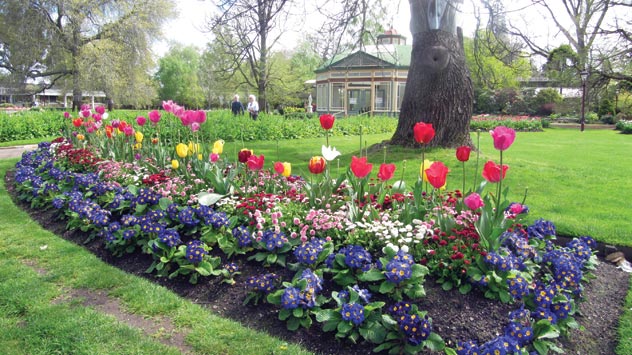
(Above): Lovely flowers, of which the gorgeous tulips are particularly noteworthy, greet visitors at the Ballarat Botanical Gardens.
You wouldn’t know it from its serene exterior today, but Ballarat is one of the most significant Victorian era boomtowns in Australia. A city in the state of Victoria, Australia, Ballarat is located at the foothills of the Great Dividing Range 65 miles north-west of the state capital Melbourne.
Gold was discovered in Poverty Point in this city in August 1851 and the area of Ballarat was later found to be a rich alluvial field where gold could easily be extracted.
News of the finds intensified the Victorian gold rush bringing over 10,000 migrants to the city from around the world within a year and transforming it from a station to a major settlement in the newly proclaimed Colony of Victoria. Australia’s first gold stamp mill was established at Ballarat in 1854.
Today all that is left of those heady days are gold rush tourist traps, which we avoided as we drove all the way from Melbourne. Instead, we stopped by to visit a gem, the Ballarat Botanical Gardens. It was a lovely day, and a riot of color greeted us, with the tulips being especially noteworthy.
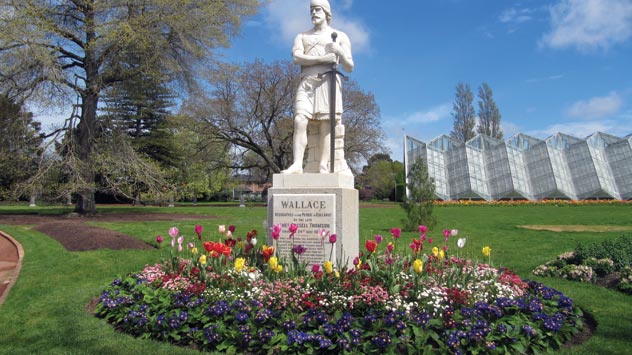
(Above): A statue of Scottish freedom fighter William “Braveheart” Wallace at the Ballarat Botanical Gardens.
The Ballarat Botanical Gardens Reserve covers an area of 40 hectares which is divided into three distinct zones. The central Botanical Gardens preserve the style of the Victorian pleasure garden. On either side there are open parkland buffers known as the North and South Gardens.
Located on the western shore of the picturesque Lake Wendouree, the gardens are an invaluable heritage and recreational resource enjoyed by the residents of Ballarat and visitors from around the world.
Ballarat itself is a tourist destination, known for its history and culture. It was the site of the Eureka Rebellion, the only armed civil uprising in Australian history which took place in December 1854 and an event controversially identified with the birth of democracy in Australia.
Many significant Australian cultural icons are also a legacy of Ballarat’s gold rush boom. The rebellion’s symbol, the Eureka Flag, has become a national symbol and is held at the Ballarat Fine Art Gallery, Australia’s oldest and largest regional gallery. Nationally significant heritage structures include the first municipal observatory established in 1886, the earliest and longest memorial avenue, the Avenue of Honor, established between 1917 and 1919 and the Ballarat Botanical Gardens, the best example of a regional botanic gardens in Australia with the greatest concentration of public statuary including the official Prime Minister’s Avenue.
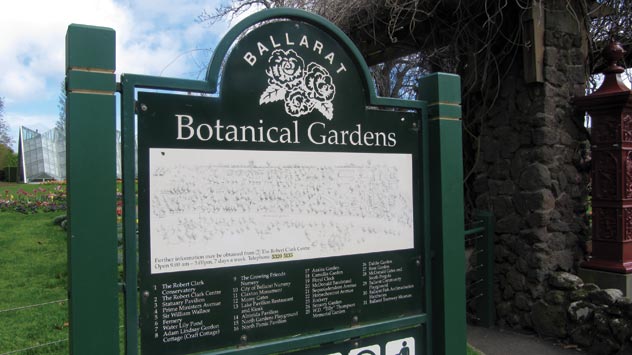
(Above): Entrance to the Ballarat Botanical Gardens.
Ballarat’s prosperity continued until late in the 19th century, when its importance relative to both Melbourne and Geelong faded with the slowing of gold extraction. It has endured as a major regional centre hosting the rowing and kayaking events from the 1956 Summer Olympics. It is the commercial capital of the Central Highlands and the largest city in the Goldfields region of Victoria
For us, the main draw was the garden.
“The Ballarat Botanical Gardens is one of Australia’s most significant cool climate gardens,” says the garden Website. “It contains a remarkable collection of mature trees and marble statues set among colorful bedding displays.”
The Statuary Pavilion houses Ballarat’s finest collection of marble statuary, the result of the Thompson Bequest. Charles Summer’s Flight from Pompeii is an elegant reminder of Ballarat’s wealth of the 1880s.
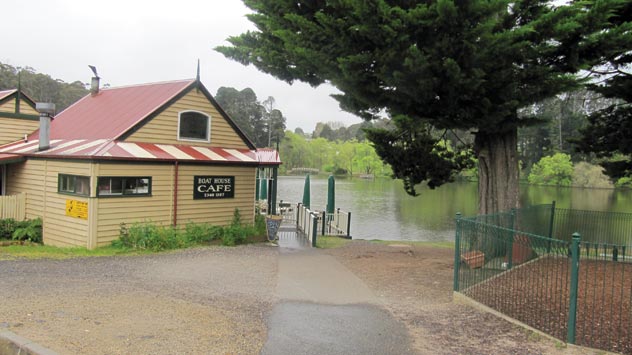
(Above): Boathouse at the nearby Lake Wendouree, an artificially created and maintained shallow urban lake.
The discovery of gold at Ballarat in 1851 changed this district from a quiet pastoral settlement to one of the most prosperous, enterprising and cosmopolitan urban areas in the world. By the 1880s the citizens of Ballarat had shown what they could do with the soil, the climate and the wealth of gold. That first generation of gold seekers had transformed their new home from a mining camp to a place of beauty in the style of their European homeland.
The development of the Gardens site began in 1858, two years after the municipality of Ballarat was formed. A Committee of Management was established and a decision was made to convert the Ballarat Police Horse Paddock into a botanical garden. At the same time it was decided to construct a road on the west side of Yuille’s Swamp (Lake Wendouree) to be known as Wendouree Parade.
A design competition for the garden was won by Messrs Wright and Anderson. The founding curator, George Longley who had trained in horticulture at Lowther Castle in England, worked long and hard at converting the design into a reality until his death in 1898. For the first 2 years he lived in a tent in the vicinity of The Robert Clark Centre and directed contractors to clear trees and cart soil from Yuille’s Swamp.
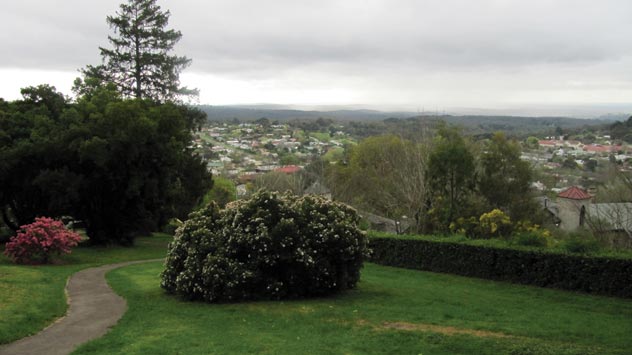
(Above): A scenic vista from a hilltop at Daylesford, a town we passed on our way to Ballarat from Melbourne.
In association with Baron von Mueller, plants and seeds were received from the Melbourne and Geelong Botanical Gardens and Longley set about a substantial propagation program in a nursery ground that he had laid out in 1859. In the 1860s the principal tree plantings that still give The Gardens their unique character were established. Of particular importance is the South Avenue of Giant Redwoods which was planted in 1863.
In the 1870s there was a fascination with exotic species from around the world and avid “plant hunting” resulted in a collection of great diversity. It was at this time that the Ballarat Fish Acclimatization Society was founded and the first zoo, with deer and aviaries, was established. Construction works included a timber Camelia House and nursery buildings.
The Robert Clark Conservatory, a must-see in the garden, was designed by Peter Elliot who has described his award-winning architecture as “derived from natural forms, crystalline and faceted, like a large transparent gemstone, held together by an intricate web of steel. My hope is to have created a building that will inspire, uplift and touch the imagination of everyone who sees it. The most inspiring aspect of the conservatory is the chance to stroll amongst the flowers, allowing people to enjoy a far more intimate view of the delicate blooms than was previously possible.”
Nearby Lake Wendouree is an artificially created and maintained shallow urban lake. “Since 1864, when a rowing course was first cut through the reedy swamp, it has been carefully nurtured by council and public spirited citizens,” says the Web site. “There is probably no better example in our country of such a well-used lake which strikes a balance between a myriad of potentially conflicting interests.”
|
|
|
|
|
|